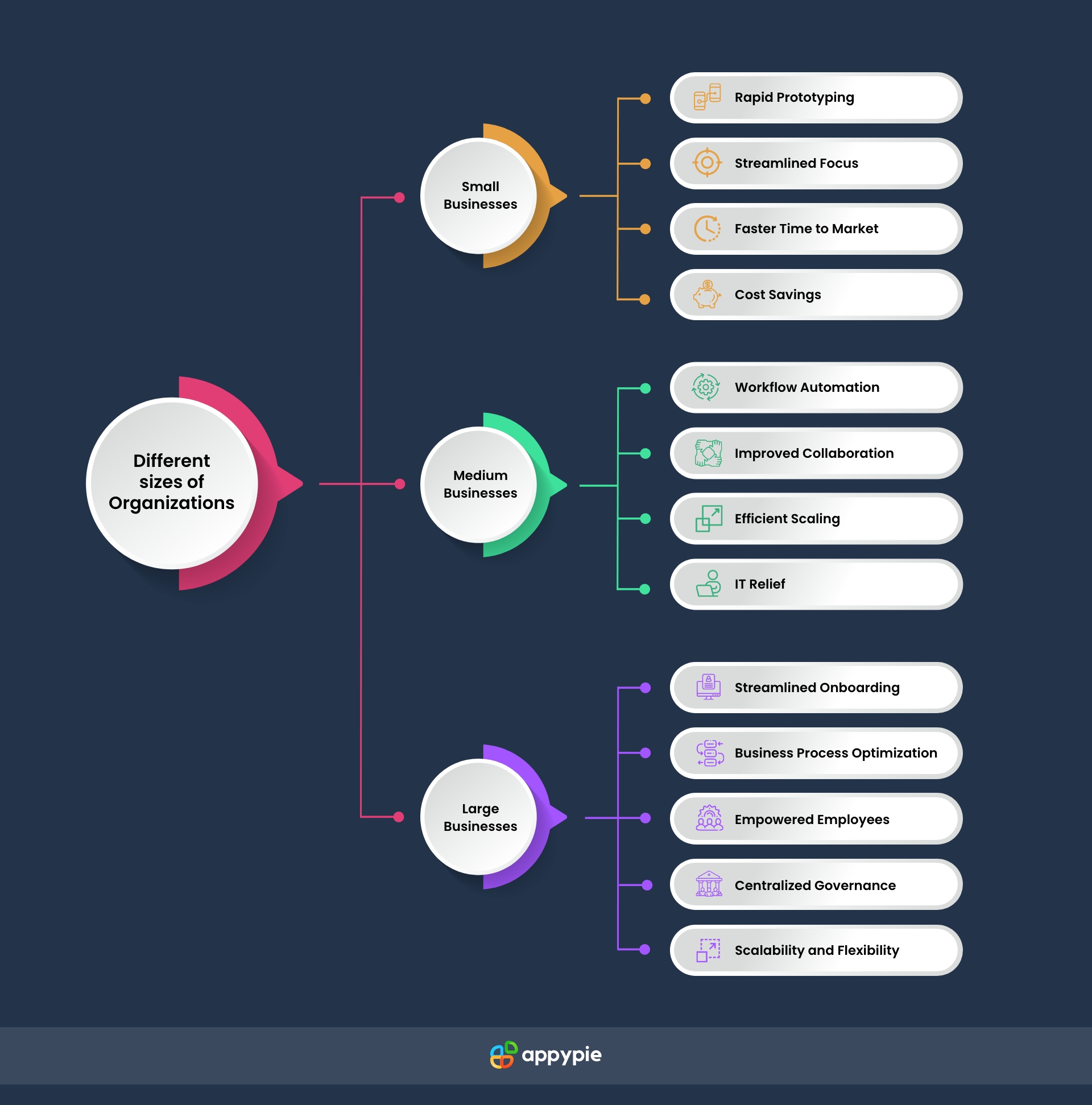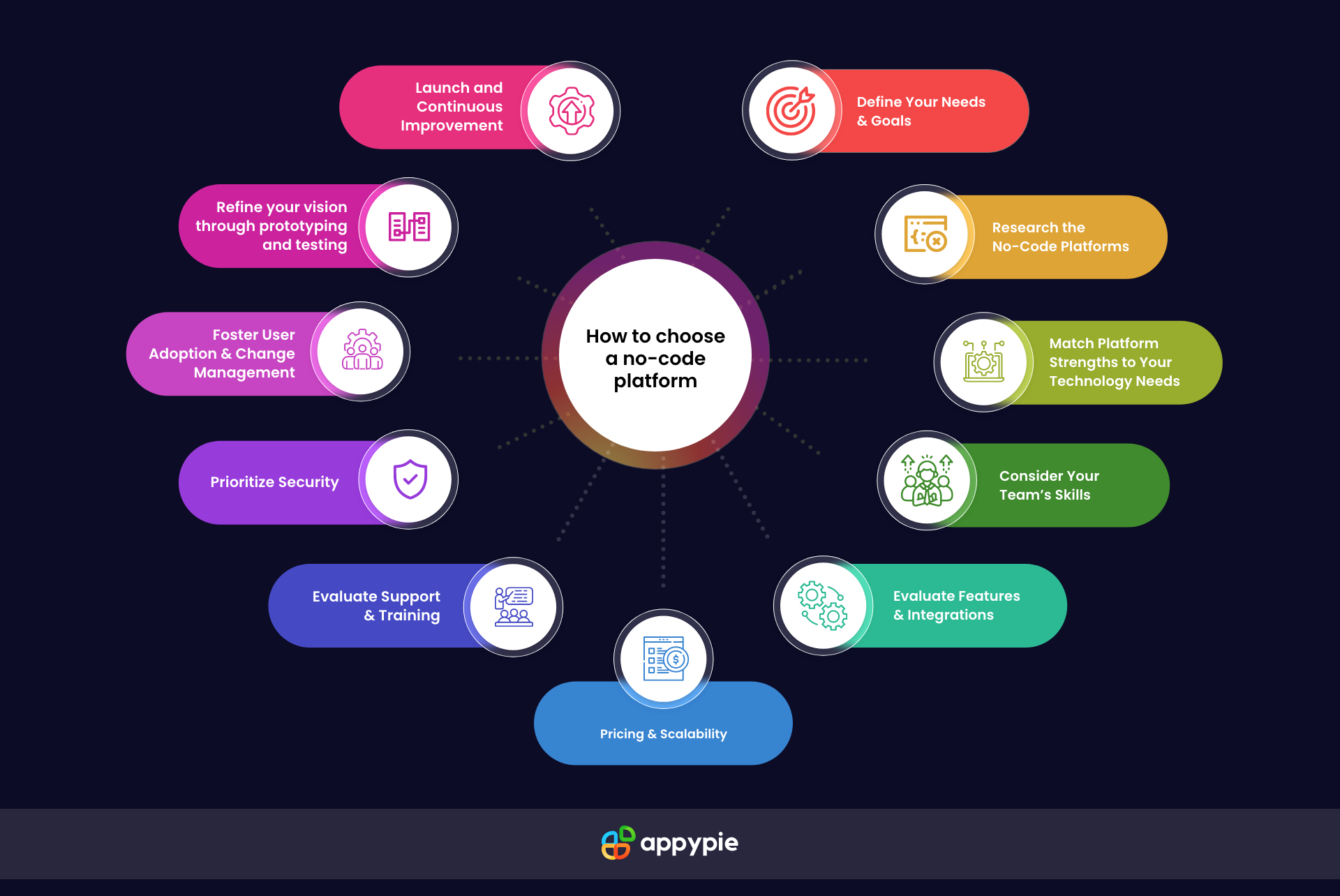11 Must-Consider Points for Choosing & Adopting the Best No-Code Development Platform

Today, the number of no-code platforms is increasing, and many of them are very popular. The result of these platforms is that you can develop apps quickly without having to learn any coding. Working with no-code tools, anyone can create an app that is both useful and attractive with the simplest drag and drop of modules that are ready to use. No-code is the best solution for businesses to develop applications themselves and in fact, 90% of all businesses that are applying no-code say it helps them grow faster.
No-code platforms are being used more and more due to the increasing demand for tech solutions that would take years to develop using the conventional methods. No-code is a method that enables businesses to rapidly design websites or apps without the need to spend much time on coding. This is the major reason for the buzz around this method.
In this blog, we will be exploring no-code platforms, the role they can play in organizations and the benefits they can bring. The process of acquiring the best no-code tools knowledge is pretty easy. We will start with the basics and build a solid foundation. Moreover, we will explore the main elements that companies should consider when selecting the best no code platform that is suitable for their requirements.
Table of Contents
- 1. How does No-Code work?
- 2. How No-Code Tools Benefit Different Types of Organizations
- 2.1. Small companies
- 2.2. Medium-sized enterprise
- 2.3. Large Enterprises
- 3. Choosing and Adopting No-Code Platforms: Key Tips
- 3.1. Define Your Objectives and Match Platform Capabilities
- 3.2. Evaluate Platforms Based on Team Expertise and Project Scope
- 3.3. Prioritize User Adoption and Long-Term Scalability
- 4. How to Choose and Use a No-Code Platform
- 4.1 Define Your Needs & Goals
- 4.2 Research the No-Code Platforms
- 4.3 Match Platform Strengths to Your Technology Needs
- 4.4 Consider Your Team's Skills
- 4.5 Evaluate Features & Integrations
- 4.6 Pricing & Scalability
- 4.7 Evaluate Support & Training
- 4.8 Prioritize Security
- 4.9 Foster User Adoption & Change Management
- 4.10 Refine your vision through prototyping and testing
- 4.11 Launch and Continuous Improvement
- 5. Appy Pie: The No-Code Platform That'll Transform Your Business
- 6. Conclusion
How does No-Code Work?
App creation used to require a lot of coding skills. But now, new platforms make it easier for anyone to create an app. These tools are called no-code platforms. They allow people without any programming experience to create apps. This has made app development accessible to more people.
Building with no-code development relies on a visual system that's easy for users. Instead of creating intricate code, individuals use pre-set components to construct an application. These components include features such as buttons, forms, and data fields. By combining these elements, users craft the app's appearance and operation, leaving the technical worries aside. The platform manages the tech-heavy specifics out of the user's sight. This approach allows users to concentrate on unleashing their creativity.
Several advanced no-code platforms employ artificial intelligence (AI) to automate standard tasks. The no code AI tools functions are capable of managing activities such as sending customized notifications or directing data according to established criteria. This automation improves the effectiveness of the app development process, saving users' valuable time and resources. No-code app development is the real thing that has made creating an app as easy as it can be, allowing people with great ideas to turn their digital dreams into reality, even without knowing how to code.
How No-Code Tools Benefit Different Types of Organizations

The growth of no-code development tools makes it easier for companies of all sizes to build their own applications. These tools enable companies to take advantage of powerful software without the need for large teams of programmers. Let’s look at the benefits no-code solutions can bring to small, medium and large businesses.
Small Companies

For small businesses and entrepreneurs, the no-code movement is a game changer. Key benefits include:
- Rapid prototyping: Non-technical founders can easily test their ideas and bring them to the workplace without hiring expensive developers. This allows them to quickly validate their concepts and implement them in their products.
- Streamlined Focus: No-code allows these people to focus more on their business and solving common problems in the industry, rather than getting lost in technical complexity.
- Faster Time to Market: Choosing a no-code platform can provide significant speed advantages, which can make a huge difference for smaller startups looking to gain a competitive edge.
- Cost Savings: Eliminating the need for dedicated developers significantly reduces the costs associated with app development, making it more accessible for small businesses with limited budgets.
Medium-Sized Enterprise

Mid-sized companies typically have more employees and more systems than small companies. No-code tools offer the following benefits:
- Workflow Automation: No-code can help create automation platforms that simplify complex HR procedures and tedious workflows such as employee onboarding, vacation management, and expense reporting.
- Improve collaboration: As your business grows, a cloud-based, no-code platform can seamlessly simplify data sharing and collaboration between departments, breaking down silos and improving communication.
- Efficient scaling: No-code solutions can meet the growing needs of mid-sized enterprises, simplifying procedure and increasing productivity as the business grows.
- IT relief: By enabling employees to build their own applications, no-code tools can significantly reduce the burden on IT departments, allowing them to focus on strategic initiatives rather than day-to-day development tasks.
Large Enterprises

Larger enterprises face their own unique challenges as they continue growing. No-code platforms can provide the following advantages:
- Streamline the onboarding process: Using no-code HR automation tools can make employee onboarding more efficient, reducing the time and resources required to onboard new employees.
- Business process optimization: As business processes become more complex, codeless business process automation tools can help streamline operations and eliminate bottlenecks, thereby increasing the overall efficiency of the organization.
- Empower employees: Self-service, no-code tools allow employees to build their own efficient processes without coding, attending a culture of innovation and problem-solving.
- Centralized governance: No-code platforms can be the main development hubs for apps, thus the IT department can be in charge and there will be more clear process in this development process.
- Scalability and Flexibility: Enterprise-grade no-code solutions can cover the expanding demands of big businesses, thus helping them keep up with market fluctuations and business transition.
Regardless of the company size, no-code solutions can benefit businesses by simplifying the app creation process, streamlining workflows, and enabling employees to build the applications they need. Whether you're a small startup or a large enterprise, no-code platforms offer an easy and accessible way to drive innovation and efficiency within your business.
Choosing and Adopting No-Code Platforms: Key Tips
The expansion of no-code platforms has given people a chance to create applications that are helpful without being a professional code writer. Picking an appropriate no-code development platform and making sure that the platform is properly accepted in your company are the most important issues that you need to deal with. It is important to think about the extent of the project, the team's abilities and the possibility of your organization to grow in the future.
1- Define Your Objectives and Match Platform Capabilities
Make the first step by expressing the problem which your no-code software is designed to handle in a clear manner. Are you looking to get the operational workflows automated, create an online customer self-service tool, or Create a mobile application for field operations? Understanding your business goals will assist you to select a no-code platform with the particular functionalities required. Analyze the level of the platform's specialization, whether it is oriented on web development, mobile app development, or process automation, to make sure that there is a match with your technical requirements.
2- Evaluate Platforms Based on Team Expertise and Project Scope
You have to know the level of technical skills of your team before you can pick a no-code solution. Some platforms are designed for citizen developers with limited coding skills, others are designed for professional developers who need more advanced features. The key is to select a platform that is aligned with the team's capabilities to ensure that the transition is smooth and development is fast. Carefully examine the platform functionality, including data management, integration possibilities, user interface customization, and security controls, to match your project demands. Also, consider the platform's scalability, pricing and training resources to ensure that you remain current with the ever changing application development landscape.
3- Prioritize User Adoption and Long-Term Scalability
Change management strategy that is well structured is critical in the launching of a new no-code platform. Effectively communicate the advantages of no-code development to your team and focus on how it simplifies processes, enables innovation, and opens up opportunities for the team to collaborate in application creation. Ensure training is available to help build confidence and address any concerns, which will enable no obstacles to a smooth user adoption and a significant impact of the organization. Another thing, choose a platform that could scale either vertically or horizontally, being able to support your growing business, larger databases and additional functionalities. Focus on integration competency to ensure that the new system will integrate smoothly into your current software stack.
By following these important steps, you will be able to go through the no-code platform selection process with confidence, and help your organization achieve successful implementation. As well, you will be able to realize the value of no-code development by turning your app ideas into reality.
How to Choose and Use a No-Code Platform
The most important thing is to select the right platform when you introduce new technology in your company. In order to implement no-code development you should make sure that the tool you choose is flexible enough to meet your requirements. We'll provide you with some key considerations to keep in mind while trying to find the right no-code tool for your organization.

Step 1. Define Your Needs & Goals
Start with clearly stating what your no-code application is trying to resolve. Would you like to automate processes, develop a self-service customer portal, or build a mobile application? Knowing exactly what you want to achieve is of great essence, as it will put you in a position of using the no-code platform that has the capabilities needed to achieve your vision. Therefore, the initial stage of the platform selection process should be clarifying the needs and requirements of your organization.
Step 2. Research the No-Code Platforms
After you have a clear conception of your project's aims, the next step is to find out about the best no-code platforms. Do a thorough research on different platforms and their features. Industry publications, review sites, and case studies can give you access to the specifics of how other businesses have used no-code solutions for the same purpose.
Step 3. Match Platform Strengths to Your Technology Needs
No-code platforms focus on different domains. Some are good at the web development tools, while others concentrate on the mobile app creation or the workflow automation features. So it is important to determine the technology needs of your application and see whether the platform is strong enough for those needs in order to develop a successful application.
Step 4. Consider Your Team's Skills
No-code platforms serve various kinds of users. Some platforms are good for citizen developers who do not have a lot of coding experience, providing drag-and-drop functionality and intuitive interfaces. On the other hand, there are platforms that have highly advanced features that cater to experienced developers. Identify a platform that is most suited to your team's technical abilities so that you can achieve an easy learning curve and process development.
Step 5. Evaluate Features & Integrations
Not all no-code platforms are the same. Make a list of the features you need for your application to be able to run smoothly and without glitches. It may offer data management tools, smooth integrations with the existing software tools, customization options for UI and strong security features. Beyond that, take into account the integration features of the platform in order to prevent data silos.
Step 6. Pricing & Scalability
Think about the platform's pricing model and its scalability in response to your business as it grows. What will be the fee structure - by user, by application, or by data storage? Make sure the platform is capable of covering the load of new users and the amount of data storage as your app becomes more popular.
Step 7. Evaluate Support & Training
This platform is itself just one component of the larger puzzle. Analyzing the vendor's support options and training materials is essential. The platform should provide extensive manuals, user guides, and readily available customer support to help your team run into and solve any difficulties during development.
Step 8. Prioritize Security
We need to have data security as a priority. Analyze the platform security measures, data encryption protocols, and the platform compliance with current industry regulations. This will make sure that your data and your users' data is safe and secured from unauthorized access.
Step 9. Foster User Adoption & Change Management
Designing a new platform requires a detailed change management strategy. Clearly show your team the advantages of no code development by explaining how it makes processes simpler and enables them to participate in app development. Offer training sessions to increase confidence and examine any issues in order to facilitate the adoption of the platform and ensure that this tool is used fully in your organization.
Step 10. Refine your vision through prototyping and testing
Before releasing your application online, it is vital to perform extensive testing. Several no-code platforms empower you to construct an initial version of your app (a prototype) to tackle any problems before investing time and resources in a complete launch. Seek input from potential users regarding your prototype. This input is crucial for optimizing your application and confirming that it satisfactorily meets their demands.
Step 11: Launch and Continuous Improvement
Once you've thoroughly tested your app and addressed any feedback, it's time to launch! Remember, no-code development is a repetitive process. As you gather user data and feedback, use it to continuously improve your application and ensure it remains valuable to your target audience.
By following these steps, you can confidently begin the no-code platform selection process, ensure successful adoption in your organization, and tackle the power of no-code development to bring your app ideas to reality.
Appy Pie: The No-Code Platform That'll Transform Your Business
Adopting and using a no-code platform that offers robust functionality can revolutionize how your organization operates. This revolutionary tool, which is designed with an user-friendly interface, enables your employees, regardless of their technical skills, to have control over their work.
Appy Pie is a top-notch no-code app development platform that can certainly assist your business in taking a step further. Visual interface and drag-and-drop features of Appy Pie make your team able to create a custom application without writing even a single line of code. No matter if you are in marketing, administration or any other department, Appy Pie's no-code features will release latent power at the organizational level. This platform is built in such a way that it is a one-stop destination for all the technology needs of your business. From automating your workflows to app builder and website builder features, Appy Pie can help you streamline your operations and drive innovation across every aspect of your company. All you have to do is jump in and you will soon experience the magic of no-code development. So why wait? Unlock the full potential of your business with Appy Pie's cutting-edge no-code solutions.
Conclusion
Alright, now we've reached the final stage of our 11 crucial aspects to take into account when selecting the best no-code platform for your company. At this point, you should be familiar with what to check and how to choose the best no code app development platform. A no-code decision is a big deal - it can have a huge impact on your company's success and competitiveness in the long-term. When you carefully assess all of the aspects that we have discussed so far, it is possible to form the best platform that could assist you to approach the multi-dimensional world of no-code platforms.
Related Articles
- Lilac Color: All You Need to Know
- Best One Page Website Templates & Your Ultimate Building Guide
- Mastering Customer Communication: 8 Strategies for Success
- LayerMerge: Neural Network Depth Compression through Layer Pruning and Merging
- Understanding the Distinctions- Help Desk vs. Service Desk
- Customer Success Playbook: A Comprehensive Manual for Your Company
- Stylus: Automatic Adapter Selection for Diffusion Models
- PPI versus DPI: What’s the Difference
- How to Design an Etsy Logo?
- Chatbots vs Virtual Assistants [Differences, Similarities, and Benefits]
Most Popular Posts
- IT Department: Understanding Specialist Teams and Tools
- How to Design a Progress Report: Importance, Checklist & Templates
- Best 7 Banking Customer Experience Trends for the Year 2024
- Slack vs. HipChat : Choosing the Best Communication Tool for Your Team
- Why Should Teachers Use Evernote For Education?
